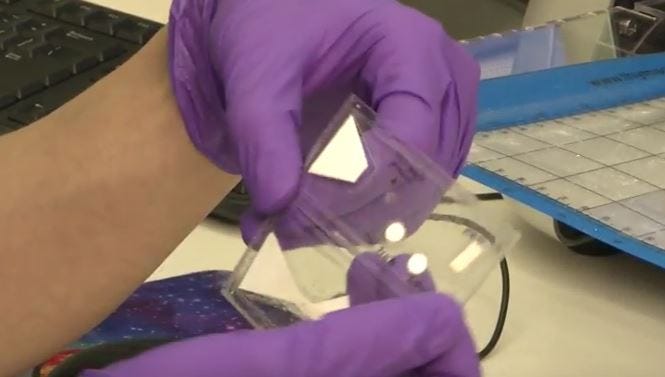Researcher ‘Shrinks’ HIV Lab Test to Piece of Paper
 The HIV test would require only a finger-prick blood sample.
The HIV test would require only a finger-prick blood sample.
Subscriber Benefit
As a subscriber you can listen to articles at work, in the car, or while you work out. Subscribe NowOne of the greatest barriers to battling HIV in developing countries is simply getting a diagnosis, says a Purdue researcher. While systems are typically in place for treatment, Purdue Assistant Professor of Biomedical Engineering Dr. Jackie Linnes says there’s a bottleneck for diagnosis. She recently earned a grant from the Bill & Melinda Gates Foundation to develop a low-cost technology—similar to an at-home pregnancy test—that could relieve the bottleneck by providing a quick and simplified HIV diagnosis.
Linnes says there are low-cost diagnostic technologies available, but they can’t detect the virus until the person has been infected for several months; the body takes that long to develop the antibodies that the test detects. Shockingly, this is also the standard test in the U.S. There are rapid diagnostic tests that take only minutes and detect HIV much earlier in its progression, but they require a high-tech laboratory setting, which is unrealistic in low-resource areas.
“Researchers in a lab have to do 10 different steps and manipulate things—it’s not at all something that could be easily converted into a process used on-site,” says Linnes.
But that’s exactly what Linnes is attempting: essentially, to take a multi-step lab process and condense it onto a small piece of paper. Amazingly, she’s well on her way and recently earned a $100,000 Grand Challenges Exploration grant to tweak her technology.
Using paper and printing techniques, Linnes is developing an HIV test that requires only a finger-prick blood sample. Rather than detecting the antibodies that take several months to develop, her diagnostic detects HIV itself—more specifically, the nucleic acids within the HIV particles—providing a much earlier diagnosis. She believes it could cost less than $2 per test and be manufactured millions at a time.
The method involves dropping the blood sample onto the pad, which has a system of tiny wax channels and valves printed on it. First, the pad filters away unnecessary components like red blood cells. A thin membrane captures just the HIV virus. Using something as low-power as the warmth from a cell phone, the wax is heated, which opens the virus particles to expose its RNA.
“There are reagents [on the pad], and when you heat them, they amplify the amount of RNA so you get lots and lots of it, so it’s detectable,” says Linnes. “We open a valve by heating the wax, and all those amplified RNA bits go downstream and end up on a line that captures them. In the same manner as a pregnancy test, they flow down and get caught there and form a red line to show they exist—that you have HIV.”
Linnes says she’d like to achieve the same “usability” as digital at-home pregnancy tests that display a simple “yes” or “no.” Her target users are community health workers who travel place to place screening for HIV. Linnes believes continued use of her diagnostic could also reveal if patients already diagnosed are getting better or worse.
“Because [my diagnostic] is able to detect low concentrations [of the virus], if your treatment is effective, then the HIV particles go lower than that concentration, [producing a negative result]—then you know things are working,” says Linnes. “If you can still detect it over time, it’s not an effective treatment, and you need to change the drug regimen.”
The Grand Challenges Exploration initiative funds “high-risk, high-reward” projects that focus on infectious diseases in the developing world; recipients have 18 months to achieve proof of concept. If successful, researchers are eligible for a $1 million follow-on grant.
“HIV absolutely is not going away anytime soon,” says Linnes. “Treating people quickly and understanding if the drug regimens are working—that’s one of the few things that’s actually going to decrease the incidence of the disease and help prevent its spread.”
By shrinking lab processes to occur on a piece of test paper, Linnes hopes to be part of a global solution.
Linnes says the diagnostic could also speed HIV testing in the U.S., where a three-month wait is the current standard.
Linnes is hopeful the diagnostic could lay the foundation for other applications.
